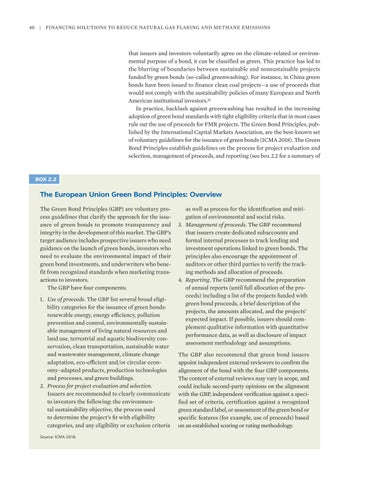40
| Financing Solutions to Reduce Natural Gas Flaring and Methane Emissions
that issuers and investors voluntarily agree on the climate-related or environmental purpose of a bond, it can be classified as green. This practice has led to the blurring of boundaries between sustainable and nonsustainable projects funded by green bonds (so-called greenwashing). For instance, in China green bonds have been issued to finance clean coal projects—a use of proceeds that would not comply with the sustainability policies of many European and North American institutional investors.14 In practice, backlash against greenwashing has resulted in the increasing adoption of green bond standards with tight eligibility criteria that in most cases rule out the use of proceeds for FMR projects. The Green Bond Principles, published by the International Capital Markets Association, are the best-known set of voluntary guidelines for the issuance of green bonds (ICMA 2018). The Green Bond Principles establish guidelines on the process for project evaluation and selection, management of proceeds, and reporting (see box 2.2 for a summary of
BOX 2.2
The European Union Green Bond Principles: Overview The Green Bond Principles (GBP) are voluntary process guidelines that clarify the approach for the issuance of green bonds to promote transparency and integrity in the development of this market. The GBP’s target audience includes prospective issuers who need guidance on the launch of green bonds, investors who need to evaluate the environmental impact of their green bond investments, and underwriters who benefit from recognized standards when marketing transactions to investors. The GBP have four components: 1. Use of proceeds. The GBP list several broad eligibility categories for the issuance of green bonds: renewable energy, energy efficiency, pollution prevention and control, environmentally sustainable management of living natural resources and land use, terrestrial and aquatic biodiversity conservation, clean transportation, sustainable water and wastewater management, climate change adaptation, eco-efficient and/or circular economy–adapted products, production technologies and processes, and green buildings. 2. Process for project evaluation and selection. Issuers are recommended to clearly communicate to investors the following: the environmental sustainability objective, the process used to determine the project’s fit with eligibility categories, and any eligibility or exclusion criteria Source: ICMA 2018.
as well as process for the identification and mitigation of environmental and social risks. 3. Management of proceeds. The GBP recommend that issuers create dedicated subaccounts and formal internal processes to track lending and investment operations linked to green bonds. The principles also encourage the appointment of auditors or other third parties to verify the tracking methods and allocation of proceeds. 4. Reporting. The GBP recommend the preparation of annual reports (until full allocation of the proceeds) including a list of the projects funded with green bond proceeds, a brief description of the projects, the amounts allocated, and the projects’ expected impact. If possible, issuers should complement qualitative information with quantitative performance data, as well as disclosure of impact assessment methodology and assumptions. The GBP also recommend that green bond issuers appoint independent external reviewers to confirm the alignment of the bond with the four GBP components. The content of external reviews may vary in scope, and could include second-party opinions on the alignment with the GBP, independent verification against a specified set of criteria, certification against a recognized green standard label, or assessment of the green bond or specific features (for example, use of proceeds) based on an established scoring or rating methodology.


